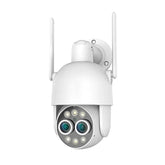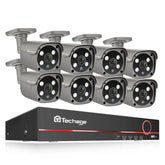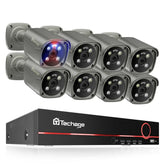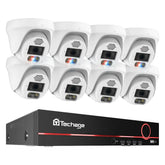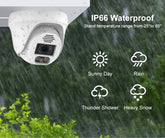The Importance of Network Security in IP Camera Systems
As the use of IP camera systems continues to rise, it is crucial to recognize the importance of network security in safeguarding these systems against hacking attacks and data breaches. IP cameras, being connected to networks, are susceptible to vulnerabilities that can be exploited by malicious actors. In this blog post, we will delve into the significance of network security in IP camera systems and explore measures to prevent hacking attacks and protect sensitive data.
Understanding the Vulnerabilities:
IP camera systems are connected to networks, making them vulnerable to cyber threats. Hackers can exploit security loopholes, weak passwords, outdated firmware, or unpatched software to gain unauthorized access. Once compromised, hackers can infiltrate the system, manipulate camera feeds, disrupt operations, or even extract sensitive data. Recognizing these vulnerabilities is the first step towards establishing a secure IP camera system.
Protecting Against Unauthorized Access:
Network security measures, such as robust authentication protocols and access controls, play a critical role in preventing unauthorized access to IP camera systems. By implementing strong passwords, two-factor authentication, and user permission settings, organizations can ensure that only authorized individuals can access the camera feeds, configuration settings, and recorded footage. This mitigates the risk of unauthorized access and reduces the likelihood of malicious activities.
To enhance network security, it is crucial to establish a robust infrastructure. This includes deploying firewalls, intrusion detection systems, and secure authentication mechanisms. Firewalls act as a barrier between internal and external networks, filtering out malicious traffic. Intrusion detection systems monitor network activity, identifying and alerting administrators about suspicious behavior. Additionally, implementing strong authentication protocols, such as multi-factor authentication, ensures only authorized individuals can access the system.
Securing Network Infrastructure:
A secure network infrastructure is vital for protecting IP camera systems from external threats. This involves regularly updating firmware and software on cameras and network devices, as manufacturers often release security patches to address vulnerabilities. Additionally, network segmentation can be implemented to isolate IP camera systems from other network devices, limiting the potential for lateral movement by hackers. Network monitoring tools can also be employed to detect and respond to any suspicious network activities promptly.
Encryption and Secure Data Transmission:
To safeguard data transmitted between IP cameras and network devices, encryption protocols such as Transport Layer Security (TLS) or Secure Shell (SSH) should be utilized. Encryption ensures that the data is transmitted in an encrypted format, making it difficult for hackers to intercept and decipher. Implementing secure transmission protocols protects against eavesdropping, tampering, and unauthorized access to sensitive video footage or configuration data.
IP camera manufacturers frequently release software updates and patches to address vulnerabilities and enhance security. It is vital to maintain a regular update and patch management process to ensure the system remains protected against emerging threats. Promptly installing updates and patches minimizes the risk of exploitation by known vulnerabilities and strengthens the overall security posture of the IP camera system.
Regular Vulnerability Assessments and Penetration Testing:
To proactively identify and address potential vulnerabilities in IP camera systems, regular vulnerability assessments and penetration testing should be conducted. These assessments help identify weaknesses in system configurations, network settings, or camera firmware that could be exploited by hackers. By addressing these vulnerabilities promptly, organizations can stay one step ahead of potential attacks and maintain a robust security posture.
Weak or default passwords are a common entry point for hackers. Implementing strong password policies, such as enforcing minimum complexity requirements and regular password changes, significantly reduces the risk of unauthorized access. Additionally, encouraging the use of password managers and educating users about the importance of secure passwords helps maintain a strong defense against potential attacks.
Network Monitoring and Intrusion Detection Systems:
Implementing network monitoring and intrusion detection systems enhances the security of IP camera systems. These systems continuously monitor network traffic, looking for patterns or anomalies that may indicate a potential security breach. They can detect suspicious activities, such as unauthorized access attempts or unusual data transfers, and trigger alerts for immediate investigation and response. Network monitoring and intrusion detection systems provide valuable insights into the security status of IP camera systems and enable swift action against potential threats.
Implementing robust monitoring and intrusion detection systems is essential for early detection and response to potential security incidents. Real-time monitoring allows administrators to identify suspicious activities, unusual network traffic, or unauthorized access attempts promptly. By setting up alerts and conducting regular security audits, organizations can proactively mitigate risks and minimize the impact of potential breaches.
Employee Awareness and Training:
Network security is a collective responsibility, and employees play a crucial role in maintaining a secure environment for IP camera systems. Organizations should prioritize employee awareness and training programs to educate staff members about best practices for network security, password management, and identifying social engineering attacks. By promoting a culture of security awareness, organizations can reduce the risk of insider threats and ensure that employees are vigilant against potential security risks.
Human error is often the weakest link in network security. Providing comprehensive user education and awareness programs helps employees understand the importance of adhering to security practices and recognizing potential threats. Regular training sessions, phishing simulations, and best practices guidelines empower users to make informed decisions and contribute to maintaining a secure IP camera system.
In the era of interconnected devices, network security plays a vital role in protecting IP camera systems from hacker attacks and data breaches. By understanding the vulnerabilities, establishing a secure network infrastructure, regularly updating software, enforcing strong password policies, implementing encryption, and conducting continuous monitoring, organizations can significantly enhance the security posture of their IP camera systems. Protecting sensitive video footage, preventing unauthorized access, and maintaining the integrity of the network infrastructure are essential for upholding the security and trustworthiness of IP camera systems. By prioritizing network security, organizations can confidently leverage the benefits of IP camera technology while safeguarding their data and maintaining a secure surveillance environment.Additionally, fostering a culture of user education and awareness ensures that all stakeholders actively participate in maintaining a secure environment. Prioritizing network security in IP camera systems is essential for safeguarding privacy, maintaining operational integrity, and preserving public trust in surveillance technology.




